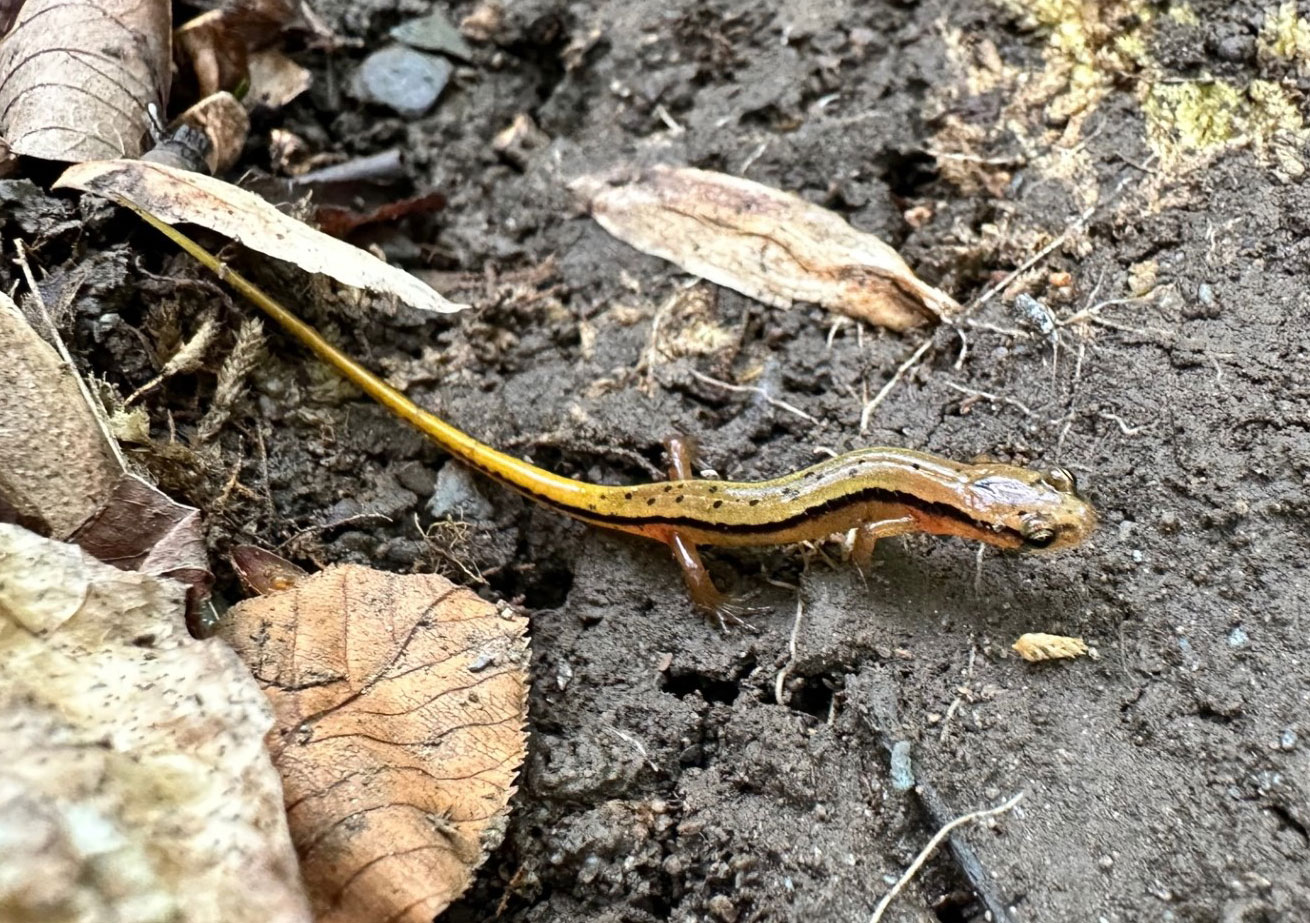
Pay a visit to Chimneys Picnic Area in Great Smoky Mountains National Park during the first days of spring, and chances are you’ll hear the cheerful sounds of families enjoying meals together, downy woodpeckers drumming on the bark of deciduous trees, and a few small groups of students talking intently amongst themselves as they carefully turn over rocks and leaves.
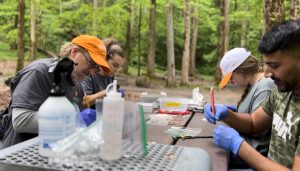
While many onlookers may think these students are simply milling around after an afternoon picnic, in fact they are taking part in a serious mission to study and help protect salamanders found nowhere else in the world.
Since their long-term study began in 2008, Dr. Matthew Gray of the University of Tennessee, Knoxville, (UTK) and Dr. William Sutton of Tennessee State University (TSU) have been bringing groups of students to select areas in the Smokies every year to monitor salamander populations for the common pathogens known as chytrid fungus and ranavirus. Both pathogens are major contributors to the global decline of amphibians.
This year, a new group of students gathers around their professors to get their simple marching orders: find the salamanders and you may find the pathogens. The students disperse, equipped with orange flags, blue rubber gloves, and small zippered plastic bags to help them safely capture and release the park’s beloved amphibians. It is not long before they begin to return, carefully bringing their salamanders to the picnic table that has become a makeshift research lab.
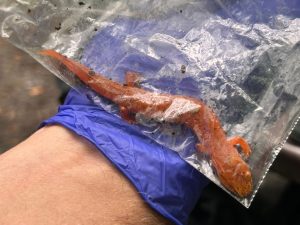
“We sample for about 45 minutes and then try to get as many species as possible, which usually is 5 to 10 species,” said Sutton. As the students arrive, he helps them identify the usual suspects, like the imitator or red-cheeked salamander. Each specimen is gently rinsed with distilled water, identified, and moved to a separate processing station to be measured and weighed.
Although some amphibians with extreme cases of chytrid fungus or ranavirus may seem lethargic or exhibit bloodshot red skin and skin ulcerations, the effects of the pathogens are not always visible to the naked eye. Chytrid fungus grows on dead plants in wet habitats and spreads to amphibians’ skin, inhibiting their inability to breath. Ranavirus is transmitted through contaminated water, physical contact, or ingestion of infected tissue.
At the final station, the students collect samples from the salamanders in order to analyze them later in a laboratory. Students remove salamanders from their bags and swab their skin, which is where chytrid fungus grows. Next, they apply a small amount of pressure to each salamander’s tail, removing a small tip to be tested for ranavirus, which attacks internal organs and can be detected in blood or tissue.
“We do not know that they are infected when we are processing them, but we take them back to the lab and we use a molecular technique called PCR that identifies the DNA of the pathogen, and we can tell if they are infected or not,” Gray said.
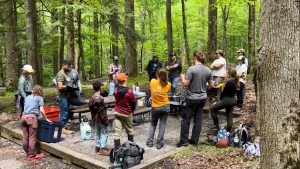
Polymerase Chain Reaction (PCR) can tell researchers if the salamanders have a low- or high-grade infection. Once the salamanders are documented, the students release each animal back to the exact spot they were captured. The next phase is waiting for lab results.
Many people have heard the phrase “no news is good news” from their healthcare professionals. Even though the research team’s goal is to perform health assessments to detect the pathogens, they’re encouraged when they fail to find the pathogens in the park. According to Gray, the team’s most recent screenings haven’t turned up much.
But while these sites have been minimally impacted by chytrid fungus and ranavirus, sites near Cades Cove in the park have seen tremendous impacts from diseases in the past.
“They have had recurring die-offs of marbled salamanders and wood frogs associated with ranavirus,” said Gray. “They can be catastrophic with thousands of animals dying in a matter of weeks.”
Human-made chemicals can also kill amphibians or stress their immune systems, leading to higher chances of transmitting pathogens.
“A lot of things that we do to the landscape can stress amphibians,” said Gray. “For example, agricultural pesticides or industrial emissions find their way into the water systems, and amphibians have permeable skin, so they just absorb the chemicals.”
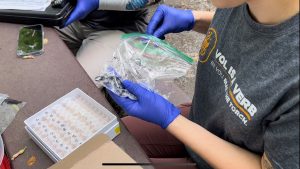
Researchers are also engaging the wildlife-trade industry to ensure that additional pathogens like the chytrid fungus or Batrachochytrium salamandrivorans (also known as Bsal) does not make it to the United States. Bsal has only been discovered in Asia and Europe and is fatal to many salamanders.
“If Bsal gets here, we estimate that about 40 percent of our species could experience declines or go extinct. In the US, that could be 80 species of salamanders gone!” said Gray.
So, how would Bsal travel across the pond? Gray says that America is the global leader in the pet amphibian trade, but these cute, colorful amphibians such as Mexico’s axolotl are often not tested for pathogens before they are shipped to America.
“We are trying to promote healthy trade by working with the pet amphibian trade industry to develop standards and a program that certifies amphibians as pathogen-free when you buy them from a pet store.”
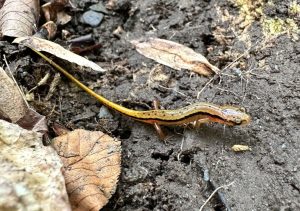
Salamanders may be small, but there is a lot to learn from our tiny neighbors, especially when it comes to human health concerns and biomedical research. Do you remember the pit that you felt in your stomach when you read that students were using samples of salamander tails for science? No need to worry. Any removed tissue will grow back due to their stem-cell capabilities.
“If a salamander has a wound, then the cells around the wound can become anything they want to be,” Gray explained. “That’s how they regenerate their limbs.” Biomedical researchers are hoping that salamanders will help them understand more about the regeneration possibilities for humans soon.
“For me, it’s about the experience. Yes, we are getting good data that the National Park Service is using to monitor the health of their salamander population, but it’s about these young scientists,” he said. “This is how the students learn—through seeing, touching, and experiencing.”
Subscribe to get the latest posts sent to your email.
The Great Smokies Welcome Center is located on U.S. 321 in Townsend, TN, 2 miles from the west entrance to Great Smoky Mountains National Park. Visitors can get information about things to see and do in and around the national park and shop from a wide selection of books, gifts, and other Smokies merchandise. Daily, weekly, and annual parking tags for the national park are also available.